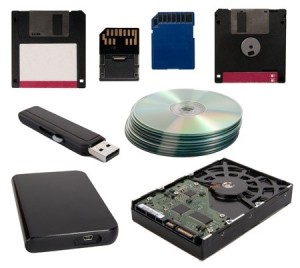
Data storage and disaster recovery methods have evolved incredibly quickly since the floppy disks of the ’70s
The first attempts at data disaster recovery actually took place during the Victorian era; that’s right, the mid-1800’s, a time when it was still common to have surgery sans anesthesia. A mathematician by the name of Charles Babbage designed the Analytical Engine, a “programmable” machine often considered the first incidence of computing technology (it even had the equivalent of a whopping 16.7 kb storage capacity!). Its programs were punched onto rectangular cards, which happened to already be in use at the time for directing mechanical looms.
Of course, it was only a matter of time before one of the punch cards became damaged during handling. When it did, the need to recover the lost data programmed onto the damaged card became apparent; if the card is damaged, the program’s damaged. Hence, the first recorded attempt at disaster recovery.
Unfortunately, it was not successful.
Not a terribly wonderful start, but it was a beginning, nonetheless. Fast forward about a hundred years to 1942, and we witness the birth of ENIAC, the first electronic general-purpose computer. Personal, however, it was not, weighing in at a monstrous 30-tons and containing over 20,000 vacuum tubes; it certainly earned its nickname, the “Giant Brain”. As for as ease-of-use, it took weeks to program it, using switches and plugboards. Hard drive data recovery was essentially nonexistent.
Progressively, it became clear that the limits of computing technology were intimately connected to storage methods and their abilities. Of course, the next logical step is to see that with changing and expanded storage capabilities, (not to mention the increasing ubiquitousness of computing technology in our lives) the need for effective data recovery methods would increase as well.
In an effort to answer that clarion call, IBM introduced the first magnetic tape drive vacuum column for data storage. Not only did this result in a decrease of lost data overall, but also made disaster recovery easier when it was necessary.
On the downhill slope of the twentieth century, a series of rapid innovations saw the parallel development of computing technology with storage methods. Floppy disks in the mid-70’s, which somehow seems oddly fitting; 1980 saw the advent of the first 5.25” HDD, along with the first Compact Disc (does anyone really call them that anymore?); flash memory was invented back in 1984, and the first Apple Macintosh went on sale; CD-ROM’s in 1985; the DVD in ’95; the Blu Ray in 2003; as we head into the 21st century, SSD, USB drives; and strides in mobile technology and the internet have been fertile ground in recent times for the development of “the cloud”.
It’s been said that those who don’t learn from history are doomed to repeat it. This brief romp through the fascinating history of data storage, and its recovery when it meets with disaster, has a lesson to teach us. Today, data storage is more critical than ever. More of our lives and businesses have become reliant upon technology, which in turn, depends upon the integrity of that storage. When it fails, as it has in the past and inevitably will again, when that drive crashes or that online storage gets hacked, the vital question becomes, where do I turn to recover what’s been lost?
Contact us today for more information on how we can help you to reclaim your lost data, and the future of your business!